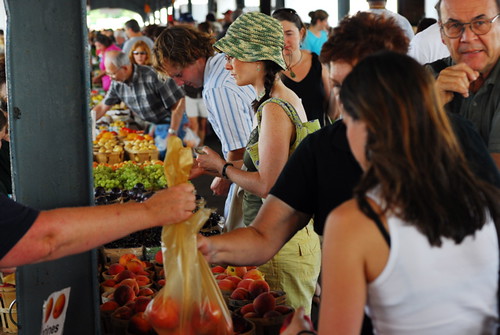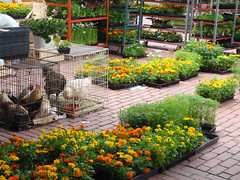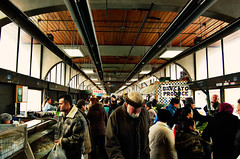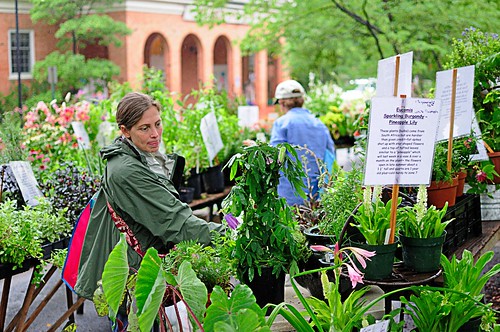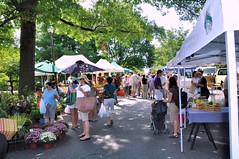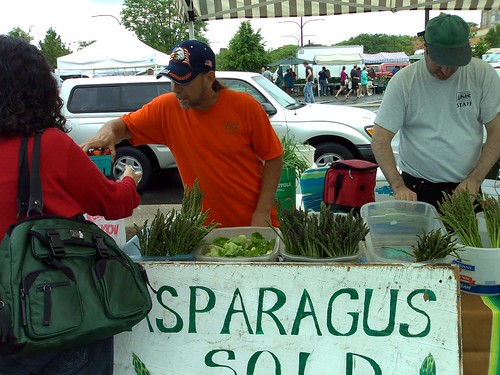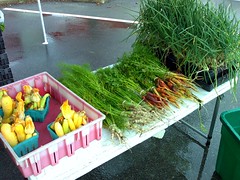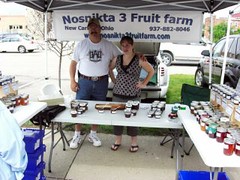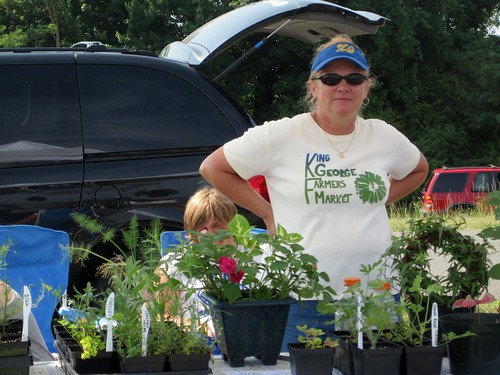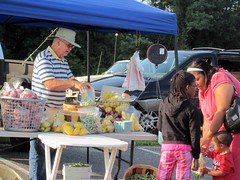America's favorite farmers' markets

Posted October 12, 2010 at 1:29PM
Farmers' markets breed community, supply healthy, local food to urban and suburban customers, and remind us of the intrinsic connection between cities and the rural landscape upon which we depend. Over the summer, the American Farmland Trust, NRDC's longtime partner in a range of collaborations, held a contest to select favorite farmers' markets in four categories distinguished by size. Winners were selected by online voting and announced last month.
The winner among the large markets (56+ vendors) was the Rochester (NY) Public Market, amazingly in operation since 1827 and pictured above. The Trust reports that the market supports more than 300 vendors, some of them in operation for several decades, with as many as 45,000 patrons per week. The market also serves important civic functions:
"The Rochester Public Market is located in the middle of the city, in a challenged neighborhood. Like other farmers markets across the country, the Rochester Public Market accepts EBT [electronic benefits transfer, similar to food stamps]Tokens, a program spearheaded by the Friends of the Public Market. The program is extremely successful, with more than $200,000 worth of tokens purchased last year, giving food stamp customers the chance to buy affordable and healthy food at the market. The Market also gathers the community for many wonderful special events during the year, including: Flower Days at the Market, Harvest Jamboree and Country Fair, Holidays at the Market, Night Markets and Bands on the Bricks, Savor Rochester Festival of Food and more."
Runner-up in this category was the Davis (CA) Farmers' Market, last year's winner.
The "medium" category (31-55 vendors) was won by the Falls Church (VA) Farmers' Market, shown above. According to the Trust, the market only allows vendors from within 125 miles of the DC suburb and draws about a thousand visitors during peak season. It operates year-round and features around 45 vendors in peak season, around 30 in the winter:
“'I think we have a great client base that is very, very supportive of the market and love coming up to the Falls Church Market and bumping into their neighbors,' says Howard Herman, the general manager of community service for the city. 'I look at the market as kind of the fabric of the city, and I think the customers also view it that way. To me, it’s a critically important aspect of the city, and something the citizens feel good about.'”
The Historic Lewes (DE) Farmers' Market took second place among the medium-sized contenders.
The Champaign County (OH) Farmers' Market placed first among small (16-30 vendors) markets. From the Farmland Trust:
"The market is nestled in the historic section of Urbana. Held every Saturday from May to October, the Champaign County Farmers Market is a vendor-operated market in the truest sense. Every board of director member must be an active vendor, and the five-year plan calls for adding a second day to the market’s schedule, eventually using a permanent structure to hold a market five days a week . . .
"The market tries to cater to the underprivileged residents in the county by accepting EBT Tokens and WIC [federal subsidies for qualifying women, infants and children]. 'We serve the whole community, not just the people that have the money to do it,' [market president Lonny] LeFever says . . . 'We are located in an area where some people struggle and many people are just trying to survive,' he says. 'The unemployment rate is terrible. Bringing EBT and the WIC program into our market, it enabled us to grow our business, and people who were left out before can come to the market and purchase good food.'"
Small market runner-up: Easton (PA) Farmers' Market.
The King George (VA) Farmers' Market allows only vendors from within rural King George County, which lacks a traditional downtown. The market won in the "boutique" (15 or fewer vendors) category. AFT says the market functions much like a community center:
"Given the relatively small size of the region, the farmers market acts as a gathering center for families and friends. The county boasts tremendous community participation, from the various activities at the King George High School to the local YMCA. The market joined events like a monthly family sing-along, a community appreciation day, and a colonial reenactment led by the local 4H Club, to grow community spirit. The local quilting club also shows its support through a raffle of two quilt patterns featuring different fruits and vegetables. Even students at the King George High School helped spread the word about the American’s Favorite Farmers Market contest through Facebook. It’s easy to see that the farmers market truly represents the community-centered mentality of the residents.
“'By and large, most of us don’t live in a neighborhood,' Padovan says. 'This gives us the common neighborhood in the county.'”
The boutique category runner-up was the Landsdowne (PA) Farmers' Market.
Move your cursor over the images for credit information.
